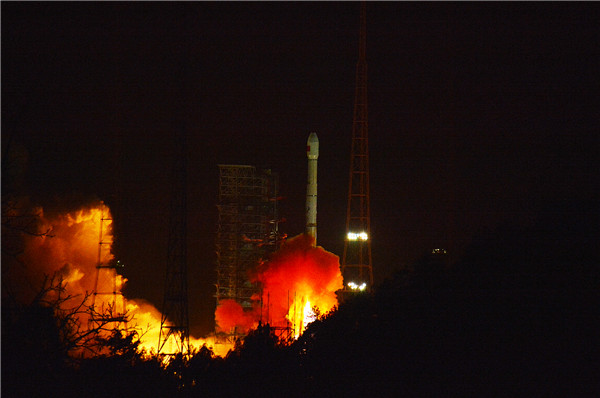
A Long March 3B rocket lifts the satellite from the Xichang Satellite Launch Center in Sichuan province at 12:04 am into the geosynchronous orbit. (Photo: People's Daily Online/Zhao Zhuqing)
China is assembling its second space laboratory and its latest manned spacecraft, and plans to send them into space in the second half of this year, according to the China Manned Space Agency.
The Tiangong 2 space lab is scheduled to be launched in the third quarter. The Shen-zhou XI spacecraft, which will carry two astronauts, will be launched in the fourth quarter and will dock with Tiangong 2, the agency said on its website on Sunday.
Astronauts will stay in the space lab for several days to test its life support systems and carry out scientific experiments.
In the first half of next year, a next-generation Long March 7 rocket will transport the Tianzhou 1 cargo spacecraft to dock with the Tiangong 2 to resupply fuel and other materials, according to the agency.
A space expert close to the program, who did not wish to be named, said: "Tiangong 2 is like a miniature space station and will have the task of testing technologies that support the long-term stay of humans. Tianzhou 1 will focus on fuel resupply technology, which is a major challenge for long-term, in-orbit operations."
The space agency said the two Shenzhou XI astronauts are receiving training, while Tiangong 2, Shenzhou XI, two Long March 2F rockets to lift them into space, the Long March 7 rocket and Tianzhou 1 are all being assembled.
China's multibillion-dollar space program, a source of increasing national pride, aims to put a permanent manned space station into service in about 2022. It will consist of three parts — a core module attached to two labs, each weighing about 20 metric tons.
By 2020, construction of the space station will be completed, according to the agency.
China launched its first space lab, Tiangong 1, in September 2011. With a designated life span of two years, it has been in service for four and a half years and is in good condition, enabling it to remain in orbit for continued operations, the agency said.
The space lab has successfully conducted six automatic and astronaut-controlled dockings with the Shenzhou VIII, Shenzhou IX and Shenzhou X spacecraft.
According to the China Aerospace Science and Technology Corp, China will carry out more than 20 space missions before the end of this year, including the manned Shen-zhou XI mission and the maiden flights of Long March 5 and Long March 7.


















































